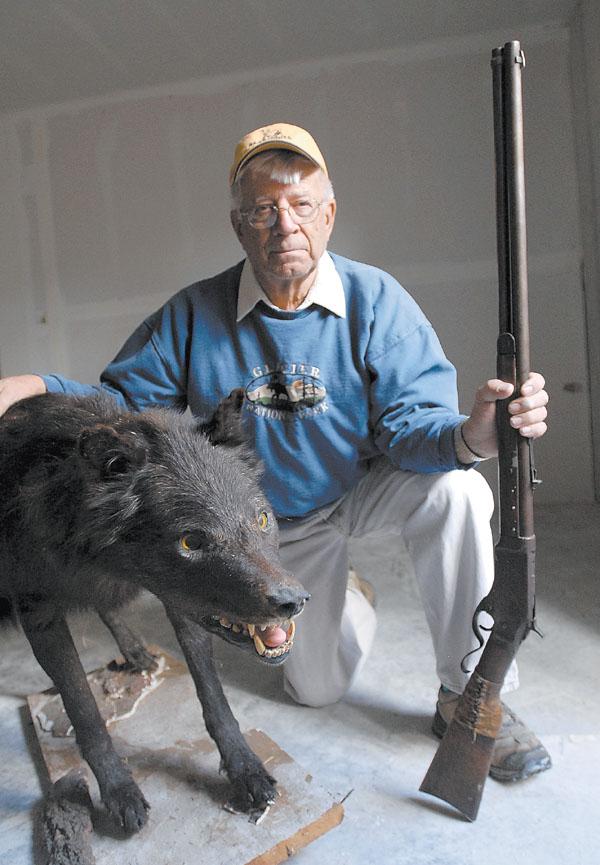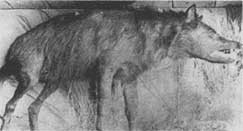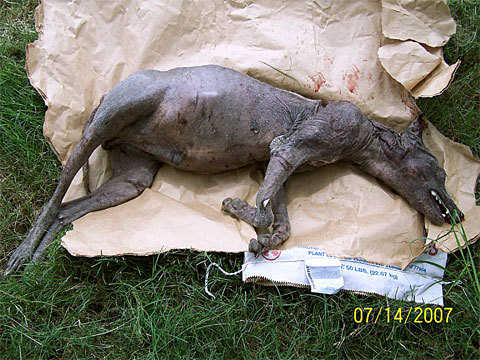
Posted on 11/15/2007 2:27:42 PM PST by BGHater
ENNIS - More than a century ago, a wolf-like creature prowled the Madison Valley, killing livestock and letting out screams that one account said would leave a person's hair standing on end.
A bullet from a Mormon settler's rifle ended the animal's life and triggered stories of the creature that were passed along through generations of family history and local folklore.
The only evidence of the creature's existence was a missing taxidermy mount and a grainy black-and-white photograph of that mount - which fueled strange speculation about what kind of animal it really was.
Now after 121 years, the taxidermy mount has been found. The creature that once spooked some of the Madison Valley's first white settlers has come home.
“I never doubted the story,” said Jack Kirby, grandson of the settler who shot the animal.
After reading a Halloween-themed Chronicle story about local legends of strange creatures, Kirby tracked down the mount in the Idaho Museum of Natural History in Pocatello.
The museum has since loaned it to him to put on display at the Madison Valley History Museum, although at the moment it resides in the basement of a building on the north edge of town.
The “ringdocus” or “shunka warak'in” - two of the names it has been given over the years - strongly resembles a wolf, but sports a hyena-like sloping back and an odd-shaped head with a narrow snout. Its coat is dark-brown, almost black, with lighter tan areas and a faint impression of stripes on its side.
It measure 48 inches from the tip of its snout to its rump, not including the tail, and stands from 27 to 28 inches high at the shoulder.
The mount is in amazingly good shape, showing no signs of wear and tear and retaining the color of the fur. It arrived in Ennis Friday.
One of its first stops was the gravesite of the man who shot it, Israel Ammon (I.A.) Hutchins.
“We took him down to the cemetery to see I.A. to let him know (the creature) is back in the valley,” said Kirby's wife, Barbara.
Hutchins shot the animal in 1886 on what is now the Sun Ranch, but not on his first try. He accidentally shot and killed one of his cows when he first spotted the creature on his land, his son Elliott Hutchins recounted in his memoirs.
He killed the strange animal when it appeared on his land a second time and traded the body with entrepreneur Joseph Sherwood for a new cow.
Sherwood was a taxidermist. He mounted the animal and put it on display in his combination store-museum at Henry's Lake in Idaho. His taxidermy collection was later given to the Idaho Museum of Natural History, where it was kept in storage.
The creature apparently baffled the people who saw it alive, and some speculated it was a hyena escaped from a circus rather than a wolf. The younger Hutchins remembered its haunting screams at night and wrote that after it was shot and in its death throes, the animal bit through a half-inch rope with a single bite and “exerted his very last strength to reach any one of us.”
The story of the “ringdocus” - as Sherwood reportedly named it - reached a national audience when the prolific writer and naturalist Ross Hutchins wrote about it in his 1977 autobiography, “Trails to Nature's Mysteries: The Life of a Working Naturalist,” and included a picture of the mount. I.A. Hutchins was his grandfather.
The tale was again picked up by writers Loren Coleman and Jerome Clark in their book “Cryptozoology A to Z.” In that book, Coleman linked it to a Native American legend about the “shunka warak'in,” a creature that snuck into camps at night to steal dogs.
The animal has so far eluded identification. The younger Hutchins wrote that a detailed description was sent to the Smithsonian Institution, which wasn't able to identify it.
The picture of the mount included the scientific-sounding name “Guyasticutus” as a label for the creature, but the name may have been tongue-in-cheek. Early accounts report that the Guyasticutus was a mythical creature invented by traveling showmen to swindle gullible ticket-buyers.
Coleman and Clark suggested that a DNA test should be done on the mount to determine what it is. Kirby, however, was not so certain he was ready to end a mystery that had been passed down by his family for four generations.
“Do we want to know?” he said.
The mount will be displayed in the Madison Valley History Museum when it reopens in May.
Walt Williams is at wwilliams@dailychronicle.com or 582-2630.


Tasmanian Tiger or wolf kept coming up in my memory so I googled that and guess what?
The Thylacine, commonly known as the Tasmanian Tiger (due to its striped back), the Tasmanian Wolf is believed to have become extinct in the 1930s.
The pictures of it online sure looks like the description and although it would have been a long way from home, it was fairly common to have odd animals and freaks in traveling shows to amaze and delight rural Americans back in the 19th century.
It’s possible that a traveling circus or carney show might have lost one of the last of the breed somewhere in Montana.
I sent a copy of my information to the reporter in Montana. What fun! No old person should be without the internet to keep up their interest in life.
Yes, I saw that too.. the length and shape of the lower jaw.... kinda looks marsupial- Like a Taz tiger...
Yes, the net is a great tool.
But I think one would have a better chance of finding a Tasmanian wol in Tasmania than in western North America.
If they are seeing the thing now, remember about what I said about breeding populations. You can’t just have a family or two of them living somewhere out west.
Coleman and Clark suggested that a DNA test should be done on the mount to determine what it is. Kirby, however, was not so certain he was ready to end a mystery that had been passed down by his family for four generations.Such test certainly lain to rest last year's Texas Chupacabras imbroglio.
Oh, and by the way, you're spelling it wrongly. Singular or plural chupacabras is spelled c-h-u-p-a-c-a-b-r-a-s, "chupacabra"
People who refer to this wonderful beasie as “chupacabra” really get my goat. When one says "chupacabra", they're refering to that entity that is “the sucker of a goat”. Chupacabras is that entitity that is “the sucker of goats”. Perhaps English speakers feel that a false plural is being formed and they resort to “s” removal. Fortunately the singular/plural issue is resolved–in Spanish–by a “definite article” placed in front of the noun (el, la, los, las, lo): One single chupacabras: “El Chupacabras” A troupe of the things: “Los Chupacabras” If female: “La Chupacabras” A cluster of females: “Las Chupacabras” So the word “Chupacabras” remains intact — no need to amputate the final “s”.
Think of it this way: sort of a Jennifer Lopez thing (good lookin' and cross cultural).


The thing is that “chupacabras” was first used on television in 1960, in an episode of the TV western, Bonanza by a Mexican character who was talking with one of the Cartwright family characters, about a creature that sucked the milk from goats, hence it being one of the “goatsuckers,” and was related to the birds, whippoorwills.
Zoologically, night jars and whippoorwills are members of the Caprimulgiformes (goatsuckers) and thus are called “Chupacabras” in Spanish. It seems a natural extension on the basis of this usage that a cryptozoological creature, a new cryptid sucking the blood from goats, would also be called a Chupacabras.
I posited that he was an animal that got loose from a traveling raree show, not a native breeding animal.
That was the one which was shot. The aarticle said that there was a reappearance of the critter.
I misread the article. I thought there were fresh sightings. The Tasmanian wolf was a marsupial and I believe their dentition is markedly different from that of placental mammals. It should be easy to check.
Disclaimer: Opinions posted on Free Republic are those of the individual posters and do not necessarily represent the opinion of Free Republic or its management. All materials posted herein are protected by copyright law and the exemption for fair use of copyrighted works.